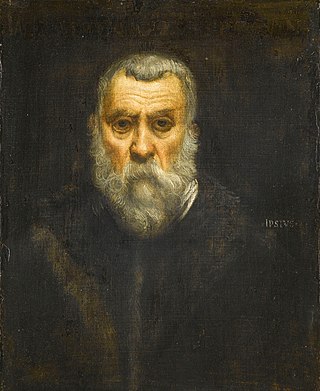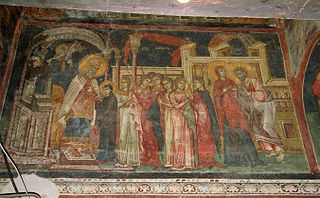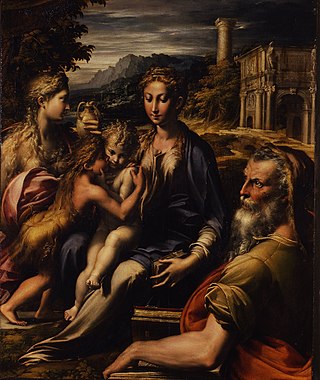
Zechariah is a Jewish figure in the New Testament and the Quran, and venerated in Christianity and Islam. In the Bible, he is the father of John the Baptist, a priest of the sons of Aaron in the Gospel of Luke, and the husband of Elizabeth who is a relative of the Virgin Mary.

The Magnificat is a canticle, also known as the Song of Mary, the Canticle of Mary and, in the Byzantine tradition, the Ode of the Theotokos. It is traditionally incorporated into the liturgical services of the Catholic Church, the Eastern Orthodox Church, Lutheran Churches and the Anglican Communion. Its name comes from the incipit of the Latin version of the text.

Jacopo Robusti, best known as Tintoretto, was an Italian Renaissance painter of the Venetian school. His contemporaries both admired and criticized the speed with which he painted, and the unprecedented boldness of his brushwork. For his phenomenal energy in painting he was termed il Furioso. His work is characterised by his muscular figures, dramatic gestures and bold use of perspective, in the Mannerist style.

Elizabeth was the mother of John the Baptist, the wife of Zechariah, and maternal aunt of Mary, mother of Jesus, according to the Gospel of Luke and in Islamic tradition. She was past normal child-bearing age when she conceived and gave birth to John.

Henry Carey, 1st Baron Hunsdon,, was an English nobleman and courtier. He was the patron of the Lord Chamberlain's Men, William Shakespeare's playing company. The son of Mary Boleyn, he was a cousin of Elizabeth I.

The Presentation of the Blessed Virgin Mary, known in the East as The Entry of the Most Holy Theotokos into the Temple, is a liturgical feast celebrated on November 21 by the Catholic, Eastern Orthodox, and some Anglo-Catholic Churches.

Sir Amias Paulet of Hinton St. George, Somerset, was an English diplomat, Governor of Jersey, and the gaoler for a period of Mary, Queen of Scots.

Maryam bint Imran is revered in Islam. The Qur'an refers to her seventy times and explicitly identifies her as the greatest woman to have ever lived. In the Quran, her story is related in three Meccan surahs and four Medinan surahs. The nineteenth Surah, Maryam, is named after her. Moreover, she is the only woman named in the Quran.

In Christianity, the Visitation, also known as the Visitation of the Blessed Virgin Mary, refers to the visit of Mary, who was pregnant with Jesus, to Elizabeth, who was pregnant with John the Baptist, in the Gospel of Luke, Luke 1:39–56. The episode is one of the standard scenes shown in cycles of the Life of the Virgin in art, and sometimes in larger cycles of the Life of Christ in art.

The Franciscan Crown is a rosary consisting of seven decades in commemoration of the Seven Joys of the Virgin, namely, the Annunciation, the Visitation, the Nativity of Jesus, the Adoration of the Magi, the Finding in the Temple, the Resurrection of Jesus, and finally, either or both the Assumption of Mary and the Coronation of the Virgin. Devotion to the seven joys of Mary is found in a variety of forms and communities. It is especially popular with the Franciscans, Cistercians, and the Annunciades of St. Joan of France. The devotion was granted many indulgences by different popes, becoming the most heavily indulgenced devotion in the Catholic Church. In order for any associated indulgences to be received it was not necessary for a Franciscan rosary to have been blessed or even to use beads at all.

Luke 1 is the first chapter of the Gospel of Luke in the New Testament of the Christian Bible. With 80 verses, it is one of the longest chapters in the New Testament. This chapter describes the birth of John the Baptist and the events leading up to the birth of Jesus. Two canticles, the canticle of Mary and the canticle of Zechariah, are both contained within this chapter. The unnamed author of Luke names its recipient, Theophilus, who is most likely a real person, but the term could simply mean a fellow believer, since theophilus is Greek for God lover. Early Christian tradition uniformly affirms that Luke composed this Gospel as well as the Acts of the Apostles, the companion volume to Luke, which is addressed to Theophilus in the same way. The title "The Gospel of Luke", found in many Bibles and some manuscripts, was added later with no indication that it was originally part of the text.

The Nativity of John the Baptist is a Christian feast day. It is observed annually on 24 June. The Nativity of John the Baptist is a high-ranking liturgical feast, kept in the Catholic Church, Eastern Orthodox Church, Anglicanism, and Lutheranism. The sole biblical account of the birth of John the Baptist comes from the Gospel of Luke.
The Quran contains references to more than fifty people and events also found in the Bible. While the stories told in each book are generally comparable, there are also some notable differences.

The Church of the Visitation is a Catholic church in Ein Karem, Jerusalem, and honors the Visitation made by the Virgin Mary, the mother of Jesus, to Elizabeth, the mother of John the Baptist. This is the site where tradition says that Mary recited her song of praise, the Magnificat, one of the most ancient Marian hymns.

The National Art Gallery of Bologna is a museum in Bologna, Italy. It is located in the former Saint Ignatius Jesuit novitiate of the city's University district, and inside the same building that houses the Academy of Fine Arts. The museum offers a wide collection of Emilian paintings from the 13th to the 18th century and other fundamental works by artists who were in some way related to the city.

According to the Islamic doctrine, Zakariyā is a prophet of God, and a father of the prophet Yahya.

Visitation or Visitation with Saint Joseph and Saint Zacharias is a c.1550 painting by Tintoretto, now in the Pinacoteca Nazionale di Bologna. Originally an altarpiece in the church of San Pietro Martire in Bologna, where it was first recorded in the seventeenth century, it was transferred to the Pinacoteca in Napoleonic times.

Madonna and Child with Saint Zechariah is a c.1530–1533 oil on panel painting by Parmigianino, now in the Uffizi. It shows the Madonna and Child with Zechariah, father of John the Baptist.

















